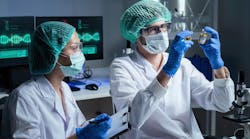Biomanufacturing Needs New Processes to Flourish
The White House recently launched a major effort in biomanufacturing to strengthen the supply chain, expand and decentralize domestic industry and bring new bio-products to market. Some training is also thrown in, regulatory innovation (including standardization) foreseen and a brand-new bio-risk reduction effort planned.
Will it succeed? That depends on the approach. Integrating all those concerns in a simple operational framework would be best.
Continuing the traditional sluggish innovation path of the life-science industry is not a good idea. The reason that drug discovery may take 10+ years is due not only to regulatory constraints—the excuse always given—but also arguably even more because of the lack of integrating an operational mindset across the value stream within each life-science company. Innovation in large companies is also slowing. On the other hand, biomanufacturing done right can have exponential effects on the economy. Here’s how.
Clearly, a plethora of exciting innovations are brewing in biotech. McKinsey expects that next-generation platform-based therapeutics—in fields such as cell and gene therapies—and personalized medicine, fueled by machine learning, will drive new waves of innovation. Yet, for all that innovation in startups, if we don’t improve the manufacturing process, even exciting bio-innovations cannot scale at the desired speed and exponential scale that society is looking for.
A case in point is Zymergen, the biomanufacturing darling that had a World Economic Forum Lighthouse plant designation, but ran into quality and production problems at its Emeryville, Calif., plant and was recently sold to Ginkgo Bioworks for a mere $300 million (and after a $500 million IPO and garnering $1 billion in venture capital). Getting innovation right in manufacturing is not just a science play, it is highly embedded in achieving effective production techniques and rapidly addressing any emerging quality concerns.
The manufacturing industry has widely not been seen as an innovation leader since Henry Ford’s assembly line. It is true that there has been a long-standing fascination with Toyota’s lean production plants, but it has been difficult for others to reproduce the results. There have been widespread automation efforts throughout the past century, and expensive machines are the pride and joy of many plant managers.
Despite the worry about replacing workers with robots and machinery, the vision of industry 4.0, a mantra for the industrial tech crowd, has largely penetrated the collective imagination as something to do with progress. What if that is not the case?
One has often assumed that manufacturing is inherently a sluggish process because of the need to coordinate production across plants, teams and sites, and along the supply chain. The organization and orchestration of these activities—operations—has not been the hottest of specialties. The other five functional areas of business management: strategy, marketing, finance, human resources and technology–have all received much more attention.
This neglect now has to come to an end. The limiting factor, one has assumed, had to be humans, because human workforce is error-prone, needs training, has annoying motivational issue and wants to be fulfilled in their work--causings tensions, friction and overhead. All of this is partially true, but it is far more than a HR issue that needs to be solved by additional budget allocations. The workforce is, in fact, not the source of slowdown, but the source of innovation.
In order to unleash the true productive potential of the workforce, one needs to move from a machine-centric to human-centric view of the factory floor. Instead of tethering people to the technology, we need to augment the workforce with unobtrusive, minimalistic technology that frees them up to move about freely and communicate with others, and with real-time access to key production data both backward and forward in the supply chain. Nowhere is this truer than in the bioproduction lab, a highly specialized type of factory, and one which now needs to scale.
Biomanufacturing today is limited by the systems industrial manufacturing has had in place for decades. The machines are perhaps the least of the problem because bio-machines (DNA sequencers and the like) are newer equipment. However, the human and software interfaces and the wider execution systems these machines are part of have never received their necessary overhaul. Industry network BioPhorum recently published something called a MES Manifesto, which you’d be likely to miss unless you are a technologist working in biomanufacturing. Missing it would be a mistake, however. The manifesto makes the point that existing “manufacturing execution systems” (a mouthful in itself) are expensive, slow to implement and lack the flexibility to be updated and supported efficiently, making them unfit for the biomanufacturing era.
So, what are the tenets of the biomanufacturing era? New biomanufacturing modalities such as those for cell and gene therapies (CGTs) require extensive parallel processing of personalized batches [that] will require full automation to be financially successful and capable of scale-up. Features that BioPhorum recommends include material identity and logistics tracking, integration with production operations and a distributed model that goes beyond traditional production cells and into the clinic.
Now to the important question of what would bring America into the biomanufacturing era. It would be tempting to say more government support or more venture capital, like the White House and McKinsey might. But the challenge is lodged in a tiny phrase: worker empowerment. The way this can work in biomanufacturing is through unleashing no-code applications in biolabs and bioproduction facilities all around, with a conscious combination of governance and hacker mentality. With digital operations apps governing cleaning work instruction, logbooks, and analytics, bio-firms of all sizes can create, deploy, collect and analyze data and production without long implementation timelines, and can adapt on the fly. The best digital operators make use of technology to augment workers, but do so sparingly.
Future, digitally enhanced biomanufacturing facilities and supply chains will evolve through bottom-up emergence more than top down, tightly controlled design and development mandated by regulatory agencies. The entire regulatory model needs overhaul, allowing for the emergence of software systems that enable biomanufacturing’s highly specific production modalities. This software must simplify, become composable, agile, modular and adaptable to novel configurations at a tap of the finger.
This is precisely the promise of a new manufacturing philosophy called Augmented Lean that entrepreneur Natan Linder and I describe in our just-released eponymous book. We should no longer have to depend on the IT department, a third party consultant, a systems integrator or major management decisions to smooth out a production bottleneck. It can be done with a clever app, built by a colleague without any professional training as a computer programmer.
While the biomanufacturing industry is greatly helped by Biden’s new bio-initiative, the true impetus would be the White House getting behind a bottom-up empowerment of an augmented workforce, one that would span the life science industry, the IT industry and a plethora of startups working in adjacent fields.
Biomanufacturing is not likely to look like the biotech industry of the 1990s or the life science industry of the 2000s. However, if we are not careful, it will, and if it does in any way resemble any of the two, we won’t see exponential growth. Then you can kiss goodbye to the end of Alzheimer’s, cancer and infectious diseases. Those breakthroughs will all come from biomanufacturing. We can have them in the next few decades with an augmented workforce, or we can have them over the next 50-75 years with the traditional approach. Which do we choose? I know the one I prefer.
Trond Arne Undheim is a futurist, podcaster, venture partner at Antler, ecosystem evangelist at Tulip, nonresident fellow at the Atlantic Council, co-founder of Yegii, and former Director of MIT Startup Exchange, based in Wellesley, MA. He holds a Ph.D. on the future of work and artificial intelligence.




